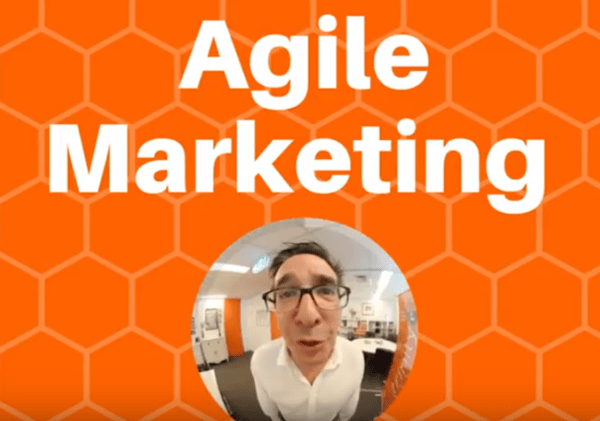This is the next in a series of one-minute videos that address one of the many complex challenges facing marketing, media and advertising today. The Golden Minute series is an attempt to prove Albert Einstein right when he said “The definition of genius is taking the complex and making it simple”.
But he also said “Everything should be made as simple as possible, but not simpler”. So we will leave it for you to judge. Please let us know here if there is a topic you would like us to cover in a Golden Minute.
Everyone is talking about Agile Marketing when they really mean agile ways to market. What’s the difference? One is a methodology and manifesto based on test and learn and the other is how to become more nimble and faster to market.
When we discuss Agile Marketing with our clients we are very clear on distinguishing the pronoun of Agile Marketing from the noun agile marketing. Agile Marketing is a process grown out of software development and adapted from the principles to a manifesto for Agile Marketing.
It is important to distinguish also the difference between agile software development and Agile Marketing.
Agile Marketing Values
- Validated learning over opinions and conventions
- Customer focused collaboration over silos and hierarchy
- Adaptive and iterative campaigns over Big-Bang campaigns
- The process of customer discovery over static prediction
- Flexible vs rigid planning
- Responding to change over following a plan
- Many small experiments over a few large bets
Agile Marketing Principles (proposed)
- Our highest priority is to satisfy the customer through early and continuous delivery of marketing that solves problems
- We welcome and plan for change. We believe that our ability to quickly respond to change is a source of competitive advantage
- Deliver marketing programs frequently, from a couple of weeks to a couple of months, with a preference to the shorter timescale
- Great marketing requires close alignment with the business people, sales and development
- Build marketing programs around motivated individuals. Give them the environment and support they need, and trust them to get the job done
- Learning, through the build-measure-learn feedback loop, is the primary measure of progress
- Sustainable marketing requires you to keep a constant pace and pipeline
- Don’t be afraid to fail; just don’t fail the same way twice
- Continuous attention to marketing fundamentals and good design enhances agility
- Simplicity is essential
For more on the Agile Marketing Manifesto you can find valuable resources to help you here.
But here are a few of our favourite examples of where marketers and their organisations have got the concept of Agile Marketing wrong.
‘Always On’ does not mean always doing the same thing
One of the key values of Agile Marketing is “Adaptive and iterative campaigns over Big-Bang campaigns”. In a conversation with a marketing team they believed they were always on because they basically ran back-to-back campaigns.
These campaigns were to a single strategy (and in fact a single media) but were never optimised or even measured to see how either the creative, media placement or strategy could be tested or improved. It actually was counter to most of the values in the Agile Marketing Manifesto.
‘Agile Marketing’ is collaborative but not meeting based
While ‘Customer focused collaboration over silos and hierarchy’ is another value of the Agile Marketing Manifesto, it is interesting how ‘collaboration’ is often interpreted as ‘more meetings’.
When we raised this with one team they pointed out that the meetings were not meetings, they were ‘stand ups’, an agile process term for a progress and sharing between teams working on a project. But in this case they were meetings in a culture that was already bogged down with meetings.
Brand and strategy are still central concepts to Agile Marketing
There is also often a misinterpretation of the Agile Marketing values of ‘Flexible vs rigid planning’ and ‘Responding to change over following a plan’. We have worked with teams who think this means they do not need a strategy or that brand consideration is not part of the process.
So much so that we have needed to prepare a presentation on this here. In fact brand and strategy are the foundation of Agile Marketing, but the agile process is about responding and optimising the customer experience as a brand and with a strategy.
Saying you are agile is not Agile Marketing
The conversation commences with the caller telling us they have become an ‘Agile Marketing’ team, but with a few quick questions on what that has meant for their corporate structure and process and it is clear that they have not become Agile Marketers, but simply embraced the label of agile marketers, for whatever that means.
Most are interested in how they can get their agencies on board to ‘drive’ the agile process. This is an interesting concept, because while there are some agencies that have adapted Agile to their operating method, most still have very linear processes.
Doing something faster is not Agile Marketing it is just quicker
The most common mistake in regards to Agile Marketing is the belief it will make you faster to market. Not in the ability to respond to customer needs in a more timely way, but in taking campaigns and activities to the market faster.
In most cases this is simply achieved, not through Agile practices, but simply shortening deadlines and timelines of the existing linear process to be ‘faster’ to market. Rather than calling this Agile Marketing and getting confused, we prefer to call it ‘fast marketing’ but like Agile Marketing it comes with changes to minimise compromise.
Golden Minute Script
Is your marketing agile?
More marketers are considering adopting agile marketing practices.
The question is why?
If you think it’s because it makes your marketing process faster, then you’re wrong.
Agile marketing is not about doing what you have always done but faster.
Agile marketing is a new marketing process
It’s based on validated learning not opinions and conventions
And customer focused collaboration rather than silos and hierarchy
It’s many adaptive and iterative actions instead of Big-Bang campaigns
And customer discovery, not static prediction
It’s flexible, not rigid planning
Means you respond to change instead of simply following a plan.
So are you ready to take on agile marketing?
If you are, then we can help you become agile.
Our Engagement Agreements service is all about ensuring an agreed campaign development process is truly achievable and adhered to. Find out more here




